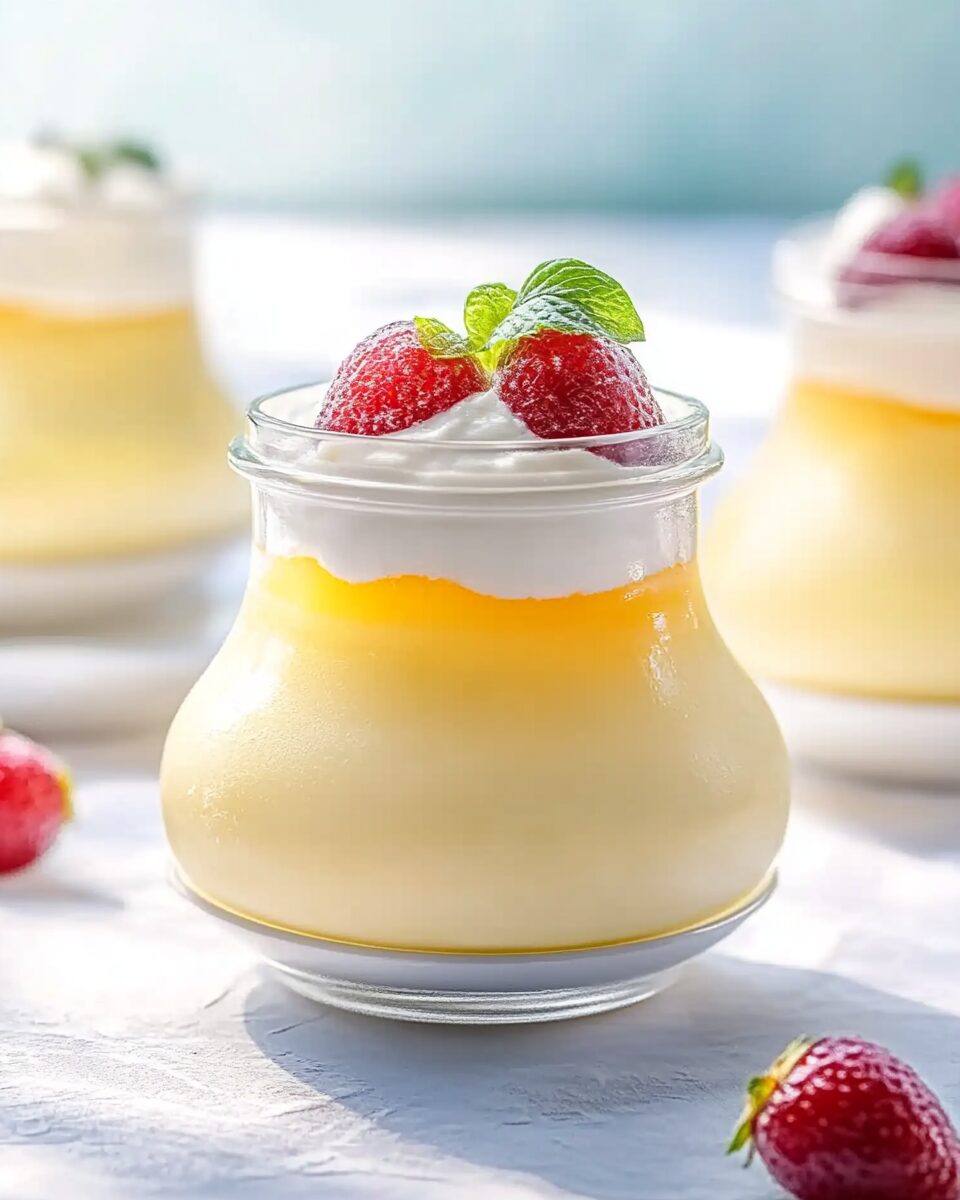Japanese Purin is a silky, no-bake custard dessert that has become a beloved treat across Japan. With its creamy, melt-in-the-mouth texture layered over a rich homemade caramel base, it closely resembles the French crème caramel or flan, yet brings its own distinctly Japanese touch. It’s light, not overly sweet, and wonderfully elegant—perfect for a delicate finish to any meal. Despite its luxurious feel, it’s incredibly easy to make at home using a few simple ingredients, making it an ideal dessert for both beginner and experienced home cooks.
Full Recipe:
Ingredients
Caramel
- Granulated sugar
- Cold water
- Hot water
Custard
- Whole milk
- Granulated sugar
- Powdered gelatin
- Pasteurized eggs
- Double cream (38% fat or more)
- Vanilla essence
Directions
-
Make the Caramel: Combine granulated sugar with one-third of the cold water in a saucepan. Stir gently before heating. Once on medium heat, do not stir—swirl the pan gently to prevent burning. When the mixture turns a deep golden color, carefully add the remaining cold and hot water in small portions to stop the cooking process. Pour the hot caramel evenly into pudding containers and allow it to set.
-
Prepare the Gelatin Mixture: In a separate jug or bowl, add gelatin to a small amount of milk and sugar. Let it sit for 5–10 minutes until bloomed. Then gently heat the mixture until the gelatin dissolves completely.
-
Make the Custard: Warm the remaining milk and combine with the cream, eggs, sugar, and vanilla essence. Slowly pour in the dissolved gelatin mixture while stirring gently to avoid air bubbles.
-
Strain and Chill: Strain the custard through a fine mesh sieve to ensure smoothness. Carefully pour the custard over the set caramel in each container. Chill in the refrigerator for at least 3 hours, or until fully set.
-
Serve: Once set, serve the purin chilled. For a classic presentation, run a knife along the edge of the container and gently invert onto a plate to release the purin with caramel on top.
Nutrients (Per Serving – Approximate, based on 6 servings)
- Calories: 210 kcal
- Protein: 5g
- Total Fat: 12g
- Saturated Fat: 7g
- Carbohydrates: 22g
- Sugars: 20g
- Fiber: 0g
- Sodium: 35mg
- Cholesterol: 95mg
The Cultural Role of Purin in Japan
Purin has become a deeply rooted element in Japanese food culture. It’s one of the most commonly found desserts in Japanese homes, cafes, school cafeterias, and even convenience stores. In fact, most convenience store chains stock at least a few types of purin in varying sizes, flavors, and textures—from ultra-soft, almost drinkable versions to thick, scoopable types.
For many, purin is a comfort food that evokes memories of childhood. It’s frequently made at home by parents as a weekend treat or enjoyed at cafes paired with tea or coffee. It’s also a popular dessert to bring to gatherings or make as a gift due to its universally loved taste and presentation.
Beyond everyday consumption, purin is featured in pop culture, anime, and television, often portrayed as a character’s favorite treat or a symbol of something homemade and filled with love. This widespread recognition further strengthens its nostalgic and emotional value within Japanese society.
Texture and Flavor Profile
The texture of purin is where it truly stands apart. It is light and bouncy yet firm enough to hold its shape when inverted onto a plate. The inclusion of gelatin or eggs—depending on the recipe—gives it a custard-like consistency without the need for baking.
The flavor is intentionally subtle. Unlike Western custards that may be loaded with vanilla, cinnamon, or citrus, purin typically relies on a gentle vanilla note, fresh creaminess from milk, and a caramel base that adds depth without overpowering the custard. This gentle flavor allows it to be appreciated by a wide range of palates, from young children to adults who prefer their sweets less intense.
The caramel sauce at the bottom brings a layer of complexity. It’s slightly bitter, acting as a counterbalance to the sweetness of the pudding. When the purin is inverted, this caramel coats the custard and creates a beautiful glossy top layer, enhancing both the appearance and the taste.
Why Purin is the Perfect Everyday Dessert
One of the reasons purin is so beloved is its accessibility. With a handful of pantry staples—milk, sugar, eggs or gelatin, and vanilla—you can create an elegant dessert that feels indulgent yet light. It doesn’t require an oven, making it ideal for warmer months or kitchens without baking equipment.
It also has a relatively short preparation time, with most recipes taking less than 30 minutes to make, followed by chilling in the refrigerator. This simplicity encourages experimentation, especially for home cooks who may want to customize it with matcha, coffee, or even seasonal fruits.
Another factor contributing to its popularity is its shelf life. Once set, purin keeps well in the refrigerator for several days, making it an excellent option for make-ahead desserts or meal prep. Its individual portion size also makes it easy to transport or serve at gatherings.
Origins and Evolution
Purin first appeared in Japan during the early 20th century as Western-style custards were introduced through European culinary influence. It quickly gained popularity due to its soft, pleasant texture and compatibility with local tastes. Over time, Japanese chefs adapted the traditional crème caramel method to better suit their audience, reducing the sweetness and focusing on simplicity.
What began as a dessert for upper-class households and Western-style cafes has evolved into an everyday treat that’s accessible to everyone. Its transformation into a cultural staple was accelerated during Japan’s economic boom when refrigeration became more common and dairy products more readily available.
In recent decades, purin has continued to evolve. Convenience stores offer seasonal varieties like chestnut purin in autumn or strawberry purin in spring. Upscale patisseries craft premium versions with specialty cream and rare vanilla beans, while home cooks enjoy creating cartoon-shaped purin for children’s bento boxes.
Modern Variations and Flavored Purin
While classic purin remains the favorite, modern variations have become increasingly popular in both Japan and abroad. Matcha (green tea) purin is a trendy alternative that blends the rich, earthy bitterness of matcha powder with the smooth custard base, creating a dessert that’s both visually appealing and uniquely flavored.
Coffee purin is another modern twist, offering a bolder, slightly bitter profile that’s especially popular among adults. Some versions incorporate espresso or drip coffee directly into the custard, while others layer a firm coffee jelly on top.
Seasonal versions also abound, including pumpkin purin in autumn, sweet potato purin, and fruit-infused varieties like mango or peach. These seasonal changes reflect Japan’s culinary dedication to freshness, seasonality, and innovation, even in traditional dishes.
There are also texture-based innovations. Some versions are deliberately made firmer, resembling flan, while others are ultra-smooth, requiring a spoon to gently scoop them out like a mousse or panna cotta.
Purin in Japanese Pop Culture
Purin holds a unique position in Japanese pop culture. It frequently appears in anime, manga, and commercials as a symbol of comfort, cuteness, or reward. It’s not uncommon to see characters bring purin as a gift, fight over the last cup in the fridge, or savor it after a long day, reinforcing its identity as a feel-good dessert.
Its popularity has even extended into character branding. The Sanrio character “Pompompurin,” a golden retriever with a pudding-shaped head, is an homage to this classic dessert. There are entire cafes themed around Pompompurin and merchandise ranging from toys to stationery.
This whimsical appeal contributes to purin’s image as a dessert that is not only delicious but also emotionally uplifting and culturally iconic.
Health and Nutrition Considerations
Compared to more elaborate desserts, purin is relatively light in calories and fat. A standard serving of homemade purin contains approximately 200 to 220 calories, depending on the ingredients used. Its simplicity helps control sugar and fat levels, especially when made with skim milk or low-sugar substitutes.
For health-conscious eaters, gelatin-based purin made without cream is a lower-calorie alternative that retains the same smooth texture. Some versions also incorporate soy milk or plant-based alternatives to suit vegan and lactose-intolerant diets.
It’s also gluten-free by nature, making it a great option for those with gluten sensitivities. Its ingredient flexibility and portion control potential make it a versatile dessert suitable for various dietary lifestyles.
Why Purin Remains a Timeless Favorite
Purin’s enduring popularity lies in its perfect blend of simplicity, elegance, and emotional resonance. It is a dessert that transcends generations, providing comfort to the elderly while delighting children with its soft texture and caramel sweetness.
Its ability to adapt to modern flavors, seasons, and trends without losing its core identity is part of what makes it so timeless. From a child’s first homemade dessert to a carefully plated finish to a gourmet meal, purin continues to hold a place in both everyday life and special occasions.
Moreover, it offers a kind of understated indulgence—elegant yet familiar, comforting yet refined. It doesn’t need elaborate decoration or over-the-top ingredients to impress. Its quiet appeal speaks volumes.
Conclusion
Japanese Purin exemplifies the beauty of minimalism in dessert-making. Simple ingredients come together to create a dish that is soft, creamy, and soul-satisfying. Whether enjoyed as a nostalgic treat, a trendy twist with matcha, or a café-style dessert, purin continues to charm palates across the world.






